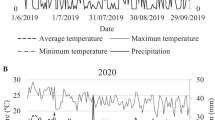Summary
Winter wheat genotypes were tested for resistance in the field by assessing the percentage sporulating leaf area after infection with wheat leaf rust. The disease level in the first field trial was too low for selection. In the second field trial a low sporulating leaf area was found on several genotypes showing a susceptible infection type. These genotypes possibly have partial resistance. Six genotypes possibly possess adult plant resistance, as they showed a resistant infection type and a low sporulating leaf area.
The latency period, infection frequency and uredosorus size of sixteen genotypes were determined in the greenhouse after infection with two races of leaf rust at two temperature regimes. The temperature × genotype interaction, found for latency period and infection frequency, was mostly influenced by the cultivars Cerco, Tundra and Miller. Adult plant resistance was postulated for four genotypes whereas another four appeared to have partial resistance.
Only one of the sixteen genotypes (Apexal) possessed adult plant resistance and two genotypes (Arminda and Cappelle Desprez) showed partial resistance in the field as well as in the greenhouse.
Similar content being viewed by others
References
Broers, L.H.M., 1989a. Influence of development stage and host genotype on three components of partial resistance to wheat leaf rust in spring wheat. Euphytica 44: 187–195.
Broers, L.H.M., 1989b. Partial resistance to wheat leaf rust in 18 spring wheat cultivars. Euphytica 44: 247–258.
Broers, L.H.M., 1989c. Race-specific aspects of partial resistance in wheat to wheat leaf rust, Puccinia recondita f.sp. tritici. Euphytica 44: 273–282.
Broers, L.H.M. & Th. Jacobs, 1989. The inheritance of host plant effect on latency period of wheat leaf rust in spring wheat. II. Number of segregating factors and evidence for transgressive segregation in F3 and F5 generations. Euphytica 44: 207–214.
Denissen, C.J.M., 1991a. Influence of race and post infection temperature on infection type in seedlings of wheat after infection with wheat leaf rust (P. recondita f.sp. tritici). Cereal Rusts and Powdery Mildews Bulletin 19: 43–47.
Denissen, C.J.M., 1991b. Influence of race and post infection temperature on components of partial resistance to leaf rust (P. recondita f.sp. tritici) in seedlings of wheat. Euphytica 58: 13–20.
Denissen, C.J.M. & P.E.L. van der Putten, 1991. Pathogenicity of wheat leaf rust (P. recondita f.sp. tritici) in the Netherlands. Cereal Rusts and Powdery Mildews Bulletin 19: 20–26.
Denissen, C.J.M., L.C.P. Keizer & K. van Spanje, 1994. Overwintering of wheat leaf rust (P. recondita f.sp. tritici) in winter wheat. Cereal Rusts and Powdery Mildews Bulletin (in preparation).
Dijk, P. van, J.E. Parlevliet, G.H.J. Kema, A.C. Zeven & R.W. Stubbs, 1988. Characterization of the durable resistance to yellow rust in old winter wheat cultivars in the Netherlands. Euphytica 38: 149–158.
Jacobs, Th. & L.H.M. Broers, 1989. The inheritance of host plant effect on latency period of wheat leaf rust in spring wheat. I. Estimation of gene action and number of effective factors in F1, F2 and backcross generations. Euphytica 44: 197–206.
Johnson, R., 1978. Practical breeding for durable resistance to rust diseases in self-pollinating cereals. Euphytica 27: 529–540.
Johnson, R. & A.J. Taylor, 1980. Pathogenic variation in Puccinia striiformis in relation to the durability of yellow rust in resistance in wheat. Ann. Appl. Biol. 94: 283–286.
Kaul, K. & G. Shaner, 1989. Effect of temperature on adult-plant resistance to leaf rust in wheat. Phytopathology 79: 391–394.
Lee, T.S. & G. Shaner, 1985. Oligogenic inheritance of length of latent period in six slow leaf-rusting wheat cultivars. Phytopathology 75: 636–643.
Lewellen, R.T., E.L. Sharp & E.R. Hehn, 1967. Major and minor genes in wheat for resistance to Puccinia striiformis and their responses to temperature changes. Can. J. Bot. 45: 2155–2172.
McNeal, F.M., C.F. Konzak, E.P. Smith, W.S. Tade & T.S. Russel, 1971. A uniform system for recording and processing cereal research data. USDA Agric. Res. Surv. Washington DC, ARS 34–121, p. 42.
Milus, E.A. & R.F. Line, 1986. Number of genes controlling high-temperature, adult plant resistance to stripe rust in wheat. Phytopathology 76: 93–96.
Neervoort, W.J. & J.E. Parlevliet, 1978. Partial resistance of barley to leaf rust, Puccinia hordei. V. Analysis of the components of partial resistance in 8 barley cultivars. Euphytica 27: 33–39.
Parlevliet, J.E., 1975. Partial resistance of barley to leaf rust, Puccinia hordei. I. Effect of cultivar and development stage on latent period. Euphytica 24: 21–27.
Parlevliet, J.E., 1976. Evaluation of the concept of horizontal resistance in the barley/Puccinia hordei host-pathogen relationship. Phytopathology 66: 494–497.
Parlevliet, J.E., 1978. Race-specific aspects of polygenic resistance of barley to leaf rust, Puccinia hordei. Neth. J. Pl. Path. 84: 121–126.
Parlevliet, J.E. & A. van Ommeren, 1975. Partial resistance of barley to leaf rust, Puccinia hordei. II. Relationship between field trials, microplot tests and latent period. Euphytica 24: 293–303.
Peterson, R.F., A.B. Campbell & A.E. Hannah, 1948. A diagrammatic scale for estimating rust intensity on leaves and stems of cereals. Can. J. Res. C26: 496–500.
Qayoum, A. & R.F. Line, 1985. High-temperature, adult-plant resistance to stripe rust of wheat. Phytopathology 75: 1121–1125.
Steel, R.G.D. & J.H. Torrie, 1981. Principles and procedures of statistics. A biometrical approach McGraw-Hill International Editions. p. 633.
Stubbs, R.W., 1985. Stripe rust. p. 61–101. In: A.P. Roelfs & W.R. Bushnell (Eds.) The Cereal Rusts II. Academic Press, New York and London.
Zadoks, J.C., 1961. Yellow rust on wheat studies in epidemiology and physiologic specialization. T. Pl. Ziekten 67: 69–256.
Zadoks, J.C., 1964. The use of race nurseries in cereal resistance breeding. p. 242–249. In: S. Broekhuizen, G. Dantuma, H. Lamberts & W. Lange (Eds.) Barley Genetics I. Pudoc, Wageningen.
Zadoks, J.C., T. Chang & C. Konzak, 1974. A decimal code for the growth stages of cereals. Weed Research 14: 415–421.
Author information
Authors and Affiliations
Rights and permissions
About this article
Cite this article
Denissen, C.J.M. Components of adult plant resistance to leaf rust in wheat. Euphytica 70, 131–140 (1993). https://doi.org/10.1007/BF00029650
Received:
Accepted:
Issue Date:
DOI: https://doi.org/10.1007/BF00029650




